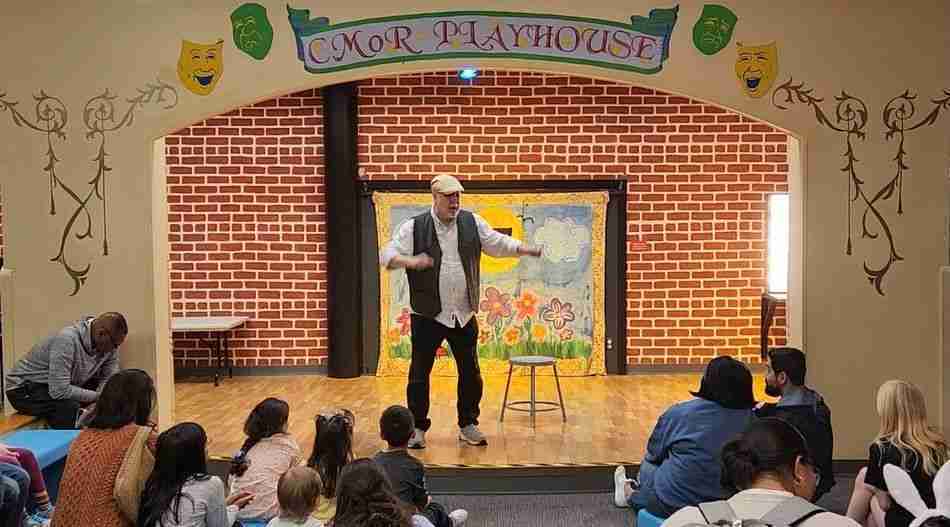
Children’s live storytelling offers children a different level of engagement than digital screens and books. Face-to-face interactions are compelling because they are:
- Interactive. Children’s live storytelling allows kids to participate in the story by asking questions, making suggestions, and even acting out parts. This interactive aspect makes the story more engaging and memorable for children.
- Engaging. Live storytellers use their voices, facial expressions, and body language to bring the story to life. This can be very captivating for children, especially if the storyteller is skilled and enthusiastic.
- Immediate. When a story is told live, children can experience it in the moment. They don’t have to wait for the next book in a series or the next episode of a TV show. This can make live storytelling more exciting and suspenseful for children.
- Social. Children’s live storytelling is often a shared experience. Children enjoy listening to stories with their friends, family, and classmates. This can help children to bond with others and to develop a love of stories.
In the following video, I point out five essential elements of good children’s storytellling:

“Wayne was excellent with our kids here at the Children’s Museum of Richmond. His stories were engaging and fun, and the entire audience participated. He was easy to work with, and was a constant professional. I could not recommend him enough for your next kid’s event.”
Joe Torrence Community Outreach Manager, Children’s Museum of Richmond
Live storytelling can also offer some specific benefits for children, such as:
- Promoting language development. Live storytelling exposes children to new words and phrases, and it helps them learn how to use language creatively and expressively.
- Developing listening skills. Live storytelling requires children to listen carefully to follow the plot and understand the characters. This can help build their listening skills, essential for success in school and life.
- Enhancing creativity and imagination. Live storytelling encourages children to use their imaginations to picture the story’s setting, characters, and events. This can help to boost their creativity and imagination.
- Teaching social and emotional skills. Live stories can teach children vital social and emotional concepts, such as friendship, courage, and kindness. Children can also learn to cope with difficult emotions, such as sadness and anger.
Overall, live storytelling is a fun and beneficial activity for children of all ages. It is a great way to expose children to new ideas, to help them develop their language and listening skills, and to teach them about important social and emotional concepts.
Here are a few popular children’s story types:
Young Children Love Classic Fairy Tales
For preschoolers, nothing beats classic fairy tales like The Three Little Pigs, Goldilocks and the Three Bears, Jack and the Beanstalk, and dozens more. Fairy tales foster imagination, curiosity, and adventure in children. They transport children to another place and make them feel various emotions—fear, happiness, worry, or excitement. Along the way, they learn moral lessons. These stories often speak to universal themes of good versus evil and moral values like hard work and kindness.
Secular Christmas Stories
In public settings, children may come from various cultural backgrounds, and their holiday traditions differ. So, I strive to find common ground with generic tales such as:
- Winter Tales: These stories focus on the winter season and its traditions
- Santa Claus Stories: These stories focus on Santa Claus and his origins
- Reindeer Stories: These stories focus on Santa Claus’ reindeer
- Christmas Magic Stories: These stories focus on the magic of the Christmas season
- Christmas Family Stories: These stories focus on the importance of family and friends during the Christmas season
These stories can be enjoyed by people of all ages and backgrounds, and they can help to create a warm and festive atmosphere during the holiday season.
Not-So-Scary Halloween Stories
Many different types of non-scary Halloween stories can be told to children. Here are a few examples:
- Stories about the history and traditions of Halloween. These stories can teach children about the origins of the holiday and the different ways it is celebrated worldwide.
- Stories about friendly ghosts and other spooky creatures. These stories can be fun and exciting without being too scary.
- Stories about the importance of friendship and cooperation. These stories can teach children that it is okay to be different and that everyone has something unique to offer.
Fractured Fairy Tales, aka Twisted Tales
Fractured fairy tales are a popular genre of children’s literature that takes classic fairy tales and twists them in unexpected and often humorous ways. Schoolchildren find these stories entertaining for a variety of reasons:
- Humor: Fractured fairy tales often use humor to subvert expectations and make familiar stories fun. Children love to laugh and appreciate the clever wordplay and unexpected twists these stories often offer.
- Predictability: Elementary school children are still developing their understanding of narrative structure, and they often enjoy predictable and easy-to-follow stories. Fractured fairy tales can provide this predictability while introducing new and surprising elements.
- Empowerment: Traditional fairy tales often feature passive protagonists who are rescued by others. Fractured fairy tales often give these characters more agency, allowing them to solve their problems and make their own choices. This can empower young readers who are still developing their own sense of independence.
- Creativity: Fractured fairy tales can inspire children to be creative and think outside the box. By seeing how familiar stories can be reimagined in new and unexpected ways, children can be encouraged to develop their own creative ideas.
Fractured fairy tales can be a great way to introduce children to classic stories while providing new and exciting experiences. These stories can be entertaining and educational, and they can help children develop their sense of humor, creativity, and critical thinking skills.
Examples of Fractured Fairy Tales
- Rumpelstiltskin and the Magic 3D Printer: A modern-day Rumpelstiltskin uses a 3D printer to spin gold and cause trouble
- The Frog Prince Who Didn’t Want to Be Kissed: A frog prince who doesn’t want to be turned human falls in love with a princess who doesn’t want to be a princess.
- Goldilocks and the Three Bears Who Were Actually Aliens: Goldilocks breaks into the home of three bears who are actually aliens and hilarity ensues.
Let Wayne Bring the Magic of Storytelling To Your Children
Bring Wayne to your classroom, school assembly, or public event to share the magic of storytelling with your children. Since Wayne began his storytelling career over five decades ago, he has entertained audiences nationwide with his traditional tales and personal stories. Contact Wayne to discuss the details of your program; you’ll be glad you did.

